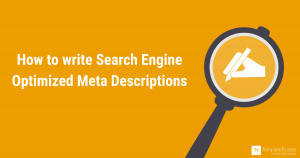How do I write a good meta description?
If you have a smaller website, you can write all meta descriptions in a couple hours or less. The workload becomes higher for sites with tons of pages or products, but it’s a project worth tackling.
- Fill it out. If you leave it empty, the search engine will auto-populate the content. While it will pull directly from the page, you don’t have any control over what gets pulled or how it appears. Take control and fill out the description.
- Write original meta descriptions for each page. Do not repeat meta descriptions across multiple pages on your site, as this can cause confusion to searchers or force multiple pages to unnecessarily compete with each other.
- Stay on topic. Identify the main topic on the page and weave this into the meta description. Generic or broad meta descriptions won’t do you any favours.
- Be descriptive and concise. You have approximately 160 characters to work with – make each and every one count. You can elaborate with your on-page content once you draw in the click.
- Write high-quality metas. Grammar matters! Use a spell-check or ask someone to proofread before you make the new descriptions live.
- Don’t be spammy. Do not keyword stuff, don’t hype up anything not found on the page, and don’t make promises you can’t deliver.
- Audit your work. Each time you add a page to your website, add an appropriate meta description. Periodically, you’ll want to conduct an audit of all meta descriptions on your site to ensure they make sense for the page and align with your messaging, unique value proposition, and targeted keywords.
How long is a meta description?
There is no character minimum or maximum for a meta description, but longer descriptions will be cut off. The cutoff point depends on the screen size – a wide-screen desktop display will generally show a longer meta description than a mobile phone display. As a general rule, if you limit your descriptions to 160 characters or 512 pixels wide, they will display fully on most devices.
Why do meta descriptions matter?
If you don’t have well-crafted meta descriptions, you’re missing out on a few major opportunities.
- Show What’s on the Page
Your meta description should give a clear, succinct summary of what you can expect to find on the page. If your meta description talks about laptops and a user clicks and ends up on a page about tablets, they’re going to be disappointed and pogo-stick back to the search results page. This will ultimately cause that page’s rankings to plummet for laptop-related keywords, because it clearly doesn’t delight users. Use the meta description to set expectations for searchers.
- Entice Readers
Showing what’s on the page is only the first step. If I write a meta description like “This page is about shoes, sneakers, an footwear,” nobody is going to be excited to click, even if they know exactly what to expect on the page. A meta description like, “Find comfortable running shoes for sale from top brands in footwear like Nike, Adidas, and New Balance. Shop now!” makes it clear what the page is about, but also draws the reader in by explaining your value. Which page would you be more likely to click?
- Qualify for Featured Snippets
Featured snippets are excerpts that appear on the search results page.

They also pull the answers to those questions you sometimes see on the search results page:

In the past, Google has pulled this data from three different sources:
- Content on Page
- Meta Description
- DMOZ Project







